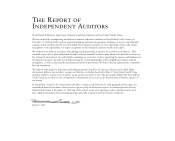Navy Federal Credit Union 2006 Annual Report Download - page 22
Download and view the complete annual report
Please find page 22 of the 2006 Navy Federal Credit Union annual report below. You can navigate through the pages in the report by either clicking on the pages listed below, or by using the keyword search tool below to find specific information within the annual report.7
6
N : S S
A P
Navy Federal Credit Union is a member-owned, not-for-
profit financial institution formed to provide a variety of
savings and lending programs to those individuals in its
field of membership which includes military and civilian
personnel who are or were employed by the Department of
the Navy and their families.
Navy Federal Financial Group (NFFG), a wholly-owned credit
union service organization, provides investment, insurance,
mortgage settlement and other financial services to members
of Navy Federal Credit Union. NFRES and Navy Federal
Brokerage Services are wholly-owned subsidiaries of NFFG.
In this Annual Report, Navy Federal Credit Union and
NFFG (consolidated) are called Navy Federal.
e significant accounting policies are:
Basis of Accounting
Navy Federal maintains its accounting records on the accrual
basis, which is in accordance with accounting principles
generally accepted in the United States of America (GAAP).
Consolidation
e consolidated financial statements include the accounts of
Navy Federal and NFFG. Significant intercompany accounts
and transactions were eliminated in consolidation.
Change in Accounting Principle
In March 2006, the Financial Accounting Standards Board
(FASB) released Statement of Financial Accounting Standards
(SFAS) No. 156, Accounting for Servicing of Financial Assets.
is statement requires all separately recognized servicing rights
to be initially measured at fair value and allows an entity an
election to subsequently measure servicing rights at fair value,
with the changes in fair value recorded in current earnings.
Navy Federal early-adopted SFAS No. 156 as of January 1,
2006, and elected to use the fair value method for subsequent
measurement for its mortgage servicing rights. As far as the
fair value election under SFAS No. 156 is concerned, Navy
Federal determined that all mortgage servicing rights belong
to one class. See Note 5 for details.
Use of Estimates
e preparation of consolidated financial statements in
conformity with GAAP requires management to make esti-
mates and assumptions that affect the reported amounts of
assets, liabilities, revenues and expenses and the disclosure of
contingent assets and liabilities in the consolidated financial
statements and accompanying notes. Actual results could dif-
fer from those estimates.
Cash
For purposes of the consolidated financial statements,
cash includes cash and balances due from banks and other
credit unions.
Short Term Investments
For purposes of the consolidated financial statements, short
term investments include federal funds sold and securities
purchased under agreements to resell, all of which have
original maturities of 90 days or less. As of December 31,
2006 and 2005, all short term investments were recorded
at cost which approximated market value.
Securities
Investment securities are classified as held-to-maturity or
available-for-sale in compliance with SFAS No. 115,
Accounting for Certain Investments in Debt and Equity
Securities. Investments classified as held-to-maturity are
carried at cost, adjusted for the amortization of premiums
and accretion of discounts. Management has the ability
and intent to hold these securities to maturity.
Securities classified as available-for-sale are carried at fair
value, with any unrealized gains and losses recorded as a
separate component of members’ equity (see Note 16).
Gains and losses on dispositions are computed using the
specific identification method. Resale and repurchase agree-
ments are treated as financing transactions and are carried at
the amounts at which the securities were initially acquired
or sold. Navy Federal takes title to securities purchased
under resale agreements, monitors the fair value of the
underlying securities, which are primarily U.S. Government
and federal agency securities, and requests additional collateral
when appropriate.
Declines in the fair value of held-to-maturity and available-
for-sale securities below their cost that are deemed to be
other than temporary are reflected in earnings as realized
losses. In estimating other-than-temporary impairment
losses, management considers (1) the length of time and
the extent to which the fair value has been less than cost,
(2) the financial condition and near-term prospects of the
issuer, (3) the intent and ability to retain the investment
for a period of time that is sufficient to allow for any
anticipated recovery in fair value, and (4) materiality.
Mortgages Held for Sale
Mortgage loans held for sale are carried at the lower of orig-
inal cost or market value in compliance with SFAS No. 65,
Accounting for Certain Mortgage Banking Activities. Market
value is determined on a loan-by-loan basis. Net unrealized
losses are recognized through a valuation allowance by
charges to income. All sales are made without recourse.
Mortgage loans held for sale are sold with the mortgage
servicing rights retained by Navy Federal.
Credit Enhanced Mortgage Loans
In February 2004, Navy Federal entered into an agreement
with Charlie Mac, LLC, an investor subsidiary of U.S.
Central Credit Union, and NFFG in which Charlie Mac
purchases up to $200 million of credit enhanced mortgage
loans from Navy Federal while Navy Federal retains the
mortgage servicing rights. Should a credit enhanced loan
default, Charlie Mac will recover the loan amount from
NFFG. e maximum total credit enhancement liability
allowed in this agreement is $8.5 million. Of that total, $1
million is set aside by NFFG as non-current restricted cash
with a designated financial institution. For the remaining
amount of $7.5 million, Navy Federal issued an irrevocable
transferable standby letter of credit to Charlie Mac as part
of the agreement. In 2004, the aggregate amount of credit
enhanced mortgage loans purchased by Charlie Mac had
reached the $200 million limit. All loans purchased pursuant
to the agreement had, at the time of origination, FICO
credit score, loan-to-value ratio and debt-to-income ratio
greater than those required by the agreement. During 2006
and 2005, no new loans were sold to Charlie Mac under
this agreement. e total principal balance of these loans as
of December 31, 2006 and 2005 was $149 million and
$162 million, respectively. To date, no loans under this
agreement have defaulted. Navy Federal has not accrued an
estimated loss regarding the credit enhanced mortgage loans
for it is less than probable that a liability had been incurred
at the date of the financial statements. Any liability reason-
ably expected to result from this agreement is not expected
to be material to Navy Federal.
Loans and Leases
Loans, except for mortgages held for sale, are stated at the
amount of unpaid principal less an allowance for loan losses.
Interest on loans is recognized on an accrual basis except
for credit card interest which is recognized on the member’s
statement date. Interest on loans is calculated using the sim-
ple-interest method on the principal amount outstanding
except for credit cards. Interest on credit cards is calculated
by applying the periodic rate to the average daily balance
outstanding. Accrual of interest on all loans is discontinued
where management believes collectibility is uncertain or
payments of principal or interest are past due by more than
90 days. All interest accrued but not collected on loans that
are placed in non-accrual status is reversed against interest
income. e interest on these loans is accounted for on the
cash-basis until the loans return to accrual status. Loans are
returned to accrual status when all the principal and interest
amounts contractually due are brought current and future
payments are reasonably assured. Funding fees for certain
mortgage loan products are deferred and amortized over
the term of the loans under SFAS No. 91, Accounting for
Nonrefundable Fees and Costs Associated With Originating
or Acquiring Loans and Initial Direct Costs of Leases. All
other origination fees and associated expenses are recognized
immediately in current earnings.
Navy Federal currently uses the direct financing method to
account for all leases. Under this method, lease contracts
receivables are the total minimum lease payments plus
residual value of the leased automobiles, net of unearned
interest revenue and deferred origination fees. Interest
revenue is recognized monthly on receipt of rental payment
and origination fees deferred are amortized to revenue over
the contractual life of the leased automobile.
Allowance for Loan Losses
Navy Federal accrues estimated losses in accordance with
SFAS No. 5, Accounting for Contingencies. e allowance for
loan losses is established through a provision for loan losses
charged to expense. Loan principal is charged against the
allowance for loan losses when management believes that
the collectibility of the amount is unlikely; subsequent
recoveries are credited to the allowance for loan losses. Navy
Federal’s loan portfolio consists mainly of large groups of
smaller balance homogeneous loans that are collectively
evaluated for impairment. e allowance for loan losses is
maintained at a level that, in management’s judgment, is
sufficient to absorb losses inherent in the portfolio, based
on evaluations of the collectibility of loans and prior loan
loss experience. e evaluations take into consideration such
factors as changes in the value of loans outstanding, prior
history of charge-offs and recoveries, overall delinquency
and delinquencies by loan product, and current economic
conditions and trends that may affect the borrowers’ ability
to pay. e allowance for loan and lease losses is reviewed
on a monthly basis and the provision that is charged to
expense is adjusted accordingly.
Fixed Assets
Land is carried at cost. Building, leasehold improvements,
furniture, fixtures, and equipment are carried at cost, less
accumulated depreciation and amortization. Buildings,
furniture, fixtures and equipment are depreciated using
the straight-line method over their estimated useful lives.
e cost of leasehold improvements is amortized over
the lease term or the useful life of the improvement,
whichever is shorter.
Useful Life
Buildings........................24to40years
Furniture and equipment . . . . . . . . . . . . .5 to 7 years
Computer equipment . . . . . . . . . . . . . . . .2 to 5 years
Computer software . . . . . . . . . . . . . . . . . . . . . .5 years
NCUSIF Deposit
e deposit in the National Credit Union Share Insurance
Fund (NCUSIF) is in accordance with the Federal Credit
Union Act and the National Credit Union Administration
(NCUA) regulations, which require the maintenance of a
deposit by each insured credit union in an amount equal to
one percent of its insured shares. e deposit would be
refunded to Navy Federal if its insurance coverage is termi-
nated, it converts to insurance coverage from another
source, or the operations of the fund are transferred from
the NCUA Board.
Goodwill
Goodwill represents the excess of purchase price over the
fair value of net assets acquired in business combinations.
SFAS No. 142, Goodwill and Other Intangible Assets,
provides that intangible assets with finite useful lives be
amortized and that goodwill and intangible assets with
indefinite lives not be amortized, but rather be tested at
least annually for impairment. Navy Federal tests goodwill
for impairment quarterly in compliance with SFAS No.
142. Impairment exists when the carrying amount of the
goodwill exceeds its implied fair value.
Derivative Financial Instruments
In compliance with SFAS No. 133, Accounting for
Derivative Instruments and Hedging Activities, all derivative
financial instruments are recognized on the balance sheet at
fair value. Changes in the fair value of derivative financial
instruments are recorded in current earnings. Navy Federal
owned the following derivative financial instruments at
December 31, 2006 and 2005: mortgage loan commit-
ments to members at specified interest rates and forward
sales contracts to offset the risk of making the mortgage
loan commitments at specified interest rates. See Note 6
for details.



















